Growing the dream
Many currents fed the Jesus myth, like streams and tributaries joining to form a major river. In order to compete with rival gods Jesus had to match them point for point, miracle for miracle. Jesus the Christ, King of Kings, Light of the World, High Priest forever, Good Shepherd, Judge of the quick and the dead, and the Saviour of Mankind is nothing less than – nothing other than – an omnibus edition of all that had gone before, the final product of ancient religious syncretism.
Not a scrap of an authentic human story is to be found. And why would there be? Jesus the man did not exist. He is a collective work of fiction and the culmination of two centuries of pious aspirations.
Civil Wars I – "Judgement Day"
Both claimants to the Hasmonean throne appealed to Rome and in 63 BC the Romans arrived and resolved matters by imposing a mosaic of client kingdoms and self-governing cities in the region (Philistia, Phoenicia, Israel, Judah, etc.). Pompey, having captured Jerusalem and strolled around the inner sanctum of the Temple – he famously remarked “It was empty” – gave the High Priesthood to Hyrcanus. Thus ended a century of Jewish independence. In Pompey’s Roman triumph of 61 BC, Aristobulus was compelled to march in front of the conqueror’s chariot in chains.
The proclaimer of God’s dawning kingdom was now identified with the image of an apocalyptic judge.
Civil War II – An Apocalyptic Age
Herod fled to to Rome and appealled directly to Octavian, himself now locked in rivalry with Antony. With the Senate’s blessing, Herod was made King of the Jews and after a 3 year campaign at the head of two Roman legions, he was finally able to enter his capital. But the situation remained volatile.
The Romans Execute a 'King of the Jews'
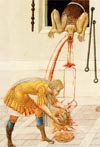
– Josephus, Antiquities, 15.1.2
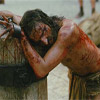
“These people Antony entrusted to a certain Herod to govern; but Antigonus he bound to a cross and flogged — a punishment no other king had suffered at the hands of the Romans — and afterwards slew him.”
– Cassius Dio, Roman History, 49. 22.
The dishonourable death of a Jewish king at the hands of Rome would shortly be overshadowed by the Battle of Actium and the downfall of Antony himself.
“During the 1st century BC as the Israelites saw less and less prospect of any human being bringing their oppression to an end, it came to be increasingly felt that only a superhuman figure and a superhuman act could be powerful enough to rescue them.“
– Michael Grant, Jesus, p97.
The Rise and Fall of the House of Herod
Pressure Cooker of Dissent
Throughout the 1st century of the common era, while the Herodian aristocracy happily danced to the tune of the caesars, the exploitation of the common people intensified. Upon their backs now weighed the priesthood, the landowning elite and the Romans. The stage was set in which rabbis, radicals and rebels would appeal to the despised and neglected masses. On offer was a hero of the people.
The Decapolis – Greek civilisation confounds the Jews

Nympheum at Jerash (Gerasa).
Impressive ruins include 3 theatres, several temples, 3 bath houses and a hippodrome.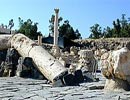
Scythopolis (Beth Shean/ Beisan)
City of the Scythes', an Iranian people from the Crimea. According to Josephus the largest city of the Decapolis.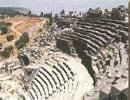
Gadara (Umm Qais).
Renowned for its artists and poets and cynic philosophers. Seven miles from the Sea of Galilee but those suicidal pigs sweated out the distance.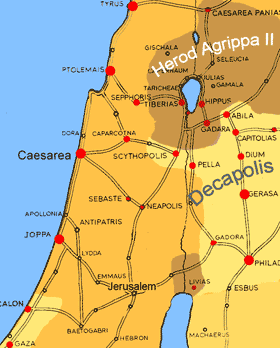
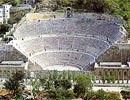
Philadelphia (Rabbath-Ammon).
Ancient capital of the Ammonites, Roman ruins include a 5000-seat theatre and a Temple of Hercules.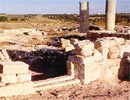
Abila (Quailibah)
Ruins of an extensive underground aqueduct system that brought water to the bath house and nympheum.
Capitolias
In 2002 archeologists found a 6000 seat amphitheatre. Much of the city remains under a blanket of olive trees and 20 meters of mud.Sources:
- Israel Shahak, Jewish History, Jewish Religion,The Weight of Three Thousand Years (Pluto, 1997)
- Michael Grant, Herod the Great (McGraw-Hill, 1971)
- Neil Faulkner, Apocalypse-The Great Jewish Revolt Against Rome AD66-73 (Tempus, 2004)
- Michael Grant, Jesus (Weidenfeld & Nicolson, 1977)
- N. Page, The Bible Book (Harper Collins, 2002)
- J. Packer, D. Williams The Bible Application Handbook (Eagle, 1999)
Related Articles:

Godman to the Max
More powerful than Zeus; more radiant than the Unconquerable Sun.
In death, suffering more agony than the suffering servant of Isaiah, yet more glorious than any conqueror’s triumph.
Roll up, roll up …
The god with everything!
No One Home
As victor he claimed the right to enter the Temple, and this incident gave rise to the common impression that it contained no representation of the deity – the sanctuary was empty and the Holy of Holies untenanted.”
– Tacitus, The Histories, 5.9.


A Judge of All Humanity
18 psalms, written during the last days of the Hasmoneans (but ascribed to “Solomon”) pass judgement on Pompey and Aristobulus and anticipate a messianic deliverer:
And now behold, ye princes of the earth, the judgement of the Lord .. judging all that is under heaven. “
– Psalms of Solomon, 2
Warning! Don't Step on the Grass
Inscription from Herod’s Temple.
“No foreigner is to enter within the balustrade and embankment around the sanctuary.
Whoever is caught will have himself to blame for his death which follows.”


Messiahs R'Us:
He launched himself into a career of arson and plunder, setting fire to the royal palace at Jericho and several other royal residences.
The commander of Herod’s guard caught and beheaded him.
"Shepherd King at Emmaus"
– Josephus, Antiquities 17
The Roman governor of Syria, Quinctilius Varus, used three of his four Syrian legions to suppress the rebellions of Simon and Athronges.

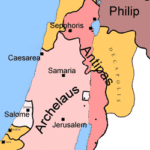
"Jesus World" – The Divided Inheritance of Herod's offspring
Palestine, first decade of 1st century AD. In the early empire the masters of Rome favoured client kings who kept their thrones by compliant behaviour and regular remittance of taxation.
Salome got her property after the fall of Archelaus. Lucky girl.
